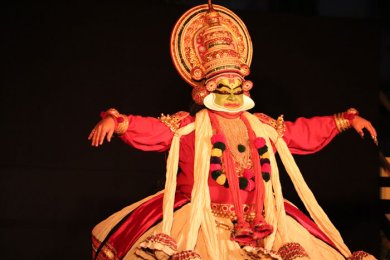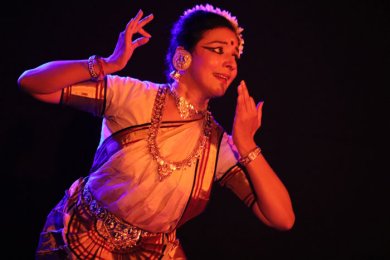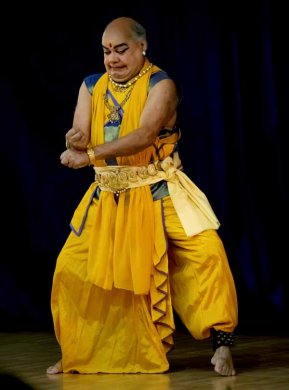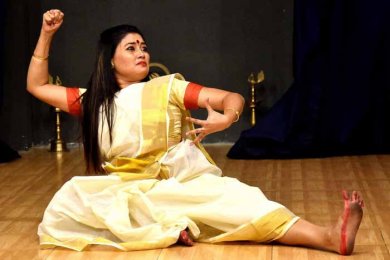
|   |

|   |
 e-mail: ukb7@rediffmail.com When Kerala connected Kolkata November 27, 2018 In the classical dance scene of Kolkata, Bharatanatyam has understandably a large number of institutions devoted to it, followed by those available for Kathak and Odissi - in no particular order. Thanks to the presence of the pioneering Guru Bipin Singh in Kolkata and influence of Santiniketan's overwhelming choice, Manipuri should have found a stronger foothold in the metropolis, but that does not seem to be the case, as seen from only a few scattered learning centres. Kuchipudi, Mohiniattam and Kathakali schools are not too many either. Sattriya being a new starter (with recognition received only in 1999) is yet to find a firm niche in the city. To set the records straight, Navanritya, an innovative synthesis of classical and folk forms by Manjushri Chaki-Sircar has a couple of centres and Gaudiya Nritya, Bengal's own tradition resurrected from sculptural and scriptural sources by Mahua Mukherjee, has its students securing Central government scholarships but no national recognition yet. Under the circumstances, the recent happenings with Mohiniattam and Kathakali were like a breath of fresh air in the city. While the performances in the first case were in keeping with the complete rigor of music and costume, in the second instance they were sans the traditional attires. Both the events drew huge applause from the large number of viewers, showing renewed interest and enthusiasm for these styles. Taal Connect Suman Sarawgi, an accomplished Manipuri dancer and Sangeeta Dudhoria, a passionate heritage enthusiast, had come together to form 'Taal Connect', promoting awareness and understanding of the deeper and subtler values of India's rich cultural tapestry including its classical arts. At its core, their mission was simple: to excite the city's young to become custodians of these arts. With their fingers unerringly on the pulse of the youth brigade, in successive years since 2016, they had hosted the noted Bharatanatyam exponent Rama Vaidyanathan and the well-known vocalist Rahul Deshpande, culminating in this year's Edition-3 with Mohiniattam artiste Vijayalakshmi Shivaji and Kathakali artiste Kalamandalam Gautam on November 11.  Kalamandalam Gautam Taking the stage first, Kalamandalam Gautam chose an episode from the popular Kerala classic Kalyanasaugandhikam, depicting an introspective dialogue between Bhima and Dharmaputra, where the former exhorts the latter for his Karuna (kind permission) to let Bhima come out of this mind-sapping exile and hurl himself on the evil Dusshasana, to tear apart the latter's entrails and bring his hot blood to re-set Draupadi's dishevelled coiffeur in sweet revenge. Bhima also wonders why Arjuna, given his mighty bow-and-arrow Gandiva, was sitting pretty idle. Set to recorded music, the narrative was composed in mellifluous Manipravalam lingo (comprising a bulk of lilting Sanskrit words). Gautam gave a very good account of himself, true to his training in the great institution.  Vijayalakshmi Shivaji Vijayalakshmi Shivaji, groomed by her mother Bharati Shivaji, the accomplished Mohiniattam exponent, has already performed in Lincoln Center, New York; Bolshoi Theatre, Moscow; and the Edinburgh Festival. She is now settled in Los Angeles where she runs her own Mohiniattam centre. Vijayalakshmi began with Mukhachalam, a pure dance item, followed by an ashtapadi from Jayadeva's Gita Govinda where a coy Radha narrates to her companion her first night's love-experience (Prathama samagama) and how she could never get over her élan to have been caressed by Krishna (Kesi Madanamutharam). Switching to a lullaby by the poet-king Swati Thirunal - set in the melodious raga Yaman Kalyan (remember Krishna ni begane baro...?) -- she ecstatically described the mother Yashoda's mollycoddling her baby, putting the little one on the cradle, finally asleep and departing from the stage to the round of audience applause -- only to turn back and admonish the spectators to remain quiet, lest they awoke the child! Her finale was, befittingly for Kolkata, a Tagore song: My mind wings its way with the clouds to distant horizons..., set to music by the distinguished Western composer Mac Quale. Her traipsing Mohiniattam steps rhymed beautifully with the unusual rhythm from the West. Vijayalakshmi had earlier conducted a 3-day workshop with around 8-9 fully-trained dancers from diverse disciplines, working for 3 ˝ hours each day. This critic thought it apt to quiz some participants on their take-away from the exposure; their learning any choreography; and specific inputs to their own dance, once they resumed their own vocations. Gargi Niyogi, a Bharatanatyam-turned-Mohiniattam dancer and the relatively junior Shaumita Hari, who learnt only Bharatanatyam since she was 3, when asked, were both most enthusiastic on the subtlety and soft cadenza of Mohiniattam and said that its seamless flow absolutely charmed them. No, they did not learn any choreography in the limited time, but the grace and the integrated approach of the style was their net gain from the exercise.The best rejoinder came from Vijayalakshmi herself, "In all too brief a workshop, I did not teach them any techniques, but tried only to share the joie de vivre of my style!" 91st Birth Anniversary of Guru Govindan Kutty Photos courtesy: Kalamandalam Kolkata  Kalamandalam Sankaranarayan The well-thought-out programme presented on November 13 by Kalmandalam, Kolkata, directed by Somnath Kutty, was a repast for the connoisseur, but it turned out equally to be a crowd-puller. First, there was a 30-minute documentary, Miles to go before I sleep, on the great guru who was one of the chosen few students by the poet Vallathol Narayana Menon at the remote village Nalakurussi in Kerala, where Vallathol had set up his nascent Centre for reviving the moribund dance of Kathakali. After obtaining his diploma, Govindan joined the Mrinalini Sarabhai troupe and toured all over the globe many times over, to celebrate the Indian Independence. Later, he joined the Rabindra Bharati University to teach Kathakali and soon became the leading light of all Kathakali performances in the east as well as the dance-dramas by Tagore -- with background singing provided by stalwarts like Hemant Kumar and Dwijen Mukhopadhyay. Produced by the Government of West Bengal, the film was quite a love's labor, containing some rare shots of Mrinalini and Govindan dancing together. Second, there was a unique monoact, Parvati Viraham, through vintage Kathakali, presented by Prof. Kalamandalam Sankaranarayan. First a teacher and then principal of Sangit Bhavana in Santinketan since 1978, Sankaranarayan has been a luminary in the Kathakali arena contributing new thoughts, structuring syllabuses and spending a lifetime in teaching countless students. Now an octogenarian, he most gracefully enacted Parvati Viraham - without the benefit of any costume - impersonating alternately the characters of Shiva as well as Parvati, apart from the occasional Ravana. To shift thus between the male and female characteristics, the actor evidently needed to empty himself and the mind had to become transparent. Parvati Viraham seemed to be the perfect window for experiencing the theory of acting: Yatho drishti thatho mana (Where the eye rests, there the mind reaches) to its fullest degree. For instance, there was sringara when Parvati gazed at Shiva's face; Earshaa when she happened to glance at Shiva's matted head housing Ganga, with whom he had hidden dalliance; then it was roudra as her gaze moved down in a process of thinking that turned into duhkha, inducing her to desert home with the children. Finally, it was sudden bhaya when Ravana rocked the Kailash Mountain and thus saved Shiva, in the nick of time, from the embarrassing confrontation with his enraged consort. It was amazing to observe how the movements of the eye, on each occasion, were transforming into the sthayi and sanchari bhavas. It was a masterly demonstration of the highest quality of Kathakali acting. Chenda accompaniment by Kalamandalam Gopa Kumar from Rabindra Bharati University and maddalam by Kalanilayam Rajan from Santiniketan were just superb, with edatalam (cymbal) by Sukumar Kutty from Kalamandalam, Kolkata -- apparently without any rehearsal beforehand!  Samraggi Ghosh Finally, Samraggi Ghosh, a disciple whom Guru Govindan had groomed for 10 years, presented Pootana Moksham in Kathakali style. This was again done without the normal costume, yet the elegance of presentation -the dancer has since switched to Kathak - was to be seen to be believed. The usual one-hour Kathakali item was telescoped into 20 minutes, which the petite dancer used with all the love and delicacy at her command. Right from the time she was charged by Kamsa with the stern instruction to kill all the tender babies in Gokula, she was suddenly enraptured with this divine child; had to goad herself again and again about her given task; took the little Krishna on her lap and remained smitten by him all the while when she was trying to make him suckle her poisoned breast milk; till the climactic moment when she was sucked out of her precious life - it was dedicated dancing, all through. "Guru Govindan was my friend, philosopher and guide, and I'll never forget the accent on 'expression' that my guru had taught me," said the young Samraggi.  Dr. Utpal K Banerjee is a scholar-commentator on performing arts over last four decades. He has authored 23 books on Indian art and culture, and 10 on Tagore studies. He served IGNCA as National Project Director, was a Tagore Research Scholar and is recipient of Padma Shri. Commments * It was a brilliant piece of writing with all the details and wonderful observations. Thank you, Narthaki, and Mr. Utpal K. Banerjee. - Somnath Govindan Kutty (Nov 30, 2018) Post your comments Please provide your name and email id when you use the Anonymous profile in the blog to post a comment. All appropriate comments posted with name & email id in the blog will also be featured in the site. |